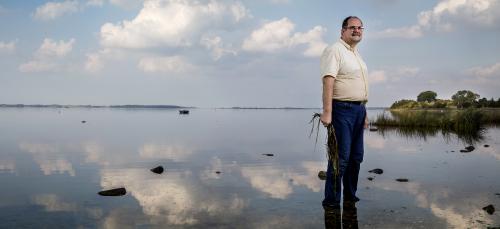Anthropogenic substances threaten Danish coastal waters more than we think

It is not enough to look at emissions of nitrogen and phosphorus when assessing the health of the Danish coastal waters. Man-made toxins, known as anthropogenic substances, such as heavy metals and pesticides, may play a surprisingly major role in the health of our coastal waters.
This is the conclusion from new research from Roskilde University.
Toxins cause more damage through the seabed
Every day, our coastal waters are exposed to heavy metals to some degree, including through ship paint and emissions from industry. Researchers have therefore taken a closer look at what happens when you expose the important plant eelgrass, also known as grass wrack, to the heavy metal copper.
Eelgrass is the most common flowering plant in the Danish fjords and coastal areas, and it is an extremely important plant because the eelgrass beds are home to an abundant fish and shellfish fauna in our coastal waters.
“It is widely recognized by scientists that anthropogenic substances affect animals in the sea. But very few people are interested in whether they also affect plants in the sea. That’s quite strange” says Søren Laurentius Nielsen, associate professor of biology and head of the research project.
Unsurprisingly, the experiments have demonstrated that copper inhibits eelgrass growth, explains the researcher. What is remarkable about the results, however, is that the harmful effect is even greater when the plants are exposed to copper in the seabed than when it is added to the sea water. The experiments focused exactly on the seabed, because this is where the anthropogenic substances are found in high concentrations after they filter down to the bottom.
Søren Laurentius Nielsen explains:
“Based on our knowledge of copper’s impact on plants, we might assume that the damage would be greatest when the substance is in contact with the plant’s leaves, because this is where photosynthesis takes place. The few experiments that were previously conducted involved adding the substances to the water, not to the seabed. But our experiments have shown that there is a much stronger effect when the substance is added to the seabed” he explains.
Threatened eelgrass
Eelgrass has been subject to difficult conditions in recent years. Although nitrogen emissions in Denmark have been reduced since the 1980s, this has not produced the anticipated recolonization of eelgrass. The importance of nitrogen should certainly not be dismissed on that account, says Søren Laurentius Nielsen. It may simply be that the damage is greater and more permanent than originally assumed. But it is also important to investigate the anthropogenic substances in future research, and to take their harmful effects seriously. The absent of eelgrass growth is an overlooked problem, he points out:
“Everyone in Denmark would panic if the beech forests in Denmark died, and we were unable to plant new beech trees. However, not many people worry about what happens in the ecosystem below the surface of the sea, and that ecosystem is very stressed right now” says Søren Laurentius Nielsen.
The new research suggests that the harmful effects are not only caused by copper, but also by other anthropogenic substances such as pesticides. This is because pesticides, like heavy metals, are found in much higher concentrations in the seabed than in the water, and because plants like eelgrass get their nutrients through their roots, just like plants on land.
Søren Laurentius Nielsen encourages both politicians and environmental planners to incorporate this new knowledge into their decisions and further work:
“My scientific recommendation is naturally that we should retain the goal of reducing emissions of nitrogen, but we also need to include other harmful factors such as anthropogenic substances" he stresses.
The new research results have recently been published in the prestigious international journal “Hydrobiologia”.
Facts
Facts about ellgrass:
Eelgrass forms dense eelgrass beds. The eelgrass beds are home to abundant animal life including snails, crabs, mussels and fish. Eelgrass is also a food for many marine birds. It thus contributes in a variety of ways to promoting biodiversity in the coastal zone. If eelgrass disappears, therefore, it will have major consequences for the animal life in the area. Eelgrass also has a positive effect on the climate, because plants absorb and retain significant amounts of CO2, and they also contribute positively to the marine environment by storing large amounts of nitrogen and phosphorus.
Source: The Danish Society for Nature Conservation
Examples of anthropogenic substances:
- Heavy metals
- Oil substances
- Pesticides
- Nano-particles